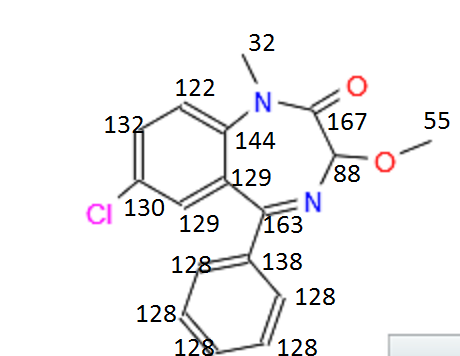Synthesis of 4-(2-(difluoromethyl)- lH-benzo[d]imidazol-
1 -yl)-6-morpholino-N-( 1 ,2,3 ,4- tetrahydronaphthalen- 1 -yl)- 1 ,3
,5-triazin-2-amine Al
Al
[00224] Compound Al was prepared according to Scheme 1, where compound 1 (l-[4- chloro-6-(4-morpholinyl)-l,3,5-tianzin-2-yl]-2-(difluoromethyl)-lH-benzimidazole) was synthesized according to the procedure as described in U.S. Pat. Appl. Publ. No.
2007/244110, the disclosure of which is incorporated herein by reference in its entirety.
[00225] A mixture of compound 1 (184 mg, 0.502 mmol) and 1,2,3,4-tetrahydro-l- naphthylamine (221 mg, 1.50 mmol) in dioxane (10 mL) was refluxed for 1 hr. The mixture was poured into ice-water (5 mL) to give a white precipitate, which was recrystallised from ethanol/water to give 65 mg (27% yield) of compound Al as a white solid: purity: 96.7% (HPLC);
MS m/z: 478.2 (M+l);
1H NMR (CDC13, 500 MHz) (rotamers) δ 8.45 (t, J= 7.5 Hz, 1H), 7.90 (t, J= 9.0 Hz, 1H), 7.71 and 7.60 (2t, JHF = 53.5 and 53.5 Hz, 1H), 7.45-7.33 (m, 3H), 7.23-7.12 (m, 3H), 5.94 and 5.77 (2d, J= 8.0 and 8.5 Hz, 1H), 5.34(d, J= 5.5 Hz, 1H), 3.94-3.82 (m, 8H), 2.82-2.77 (m, 2H), 2.18-1.81 (m, 4H) ppm.
Example 2
Synthesis of (5)-4-(2-(difluoromethyl)- lH-benzo[d]imidazol- 1 -yl)-6-morpholino-N-( 1 ,2,3 ,4- tetrahydronaphthalen- 1 -yl)- 1 ,3 ,5-triazin-2-amine A2
A2
[00226] Compound A2 was synthesized according to the procedure for compound Al substituting (5)-l,2,3,4-tetrahydro-l-naphthylamine in place of 1,2,3, 4-tetrahydro-l- naphthylamine to give the product in 61% yield: 98.2% purity (HPLC);
MS m/z: 478.1 (M+l);
1H NMR (CDCls, 500 MHz) δ 8.48-8.40 (m, 1H), 7.91 (t, J= 8.0 Hz, 1H), 7.67 and 7.66 (2t, JHF = 53.5 and 54.0 Hz, 1H), 7.45-7.35 (m, 3H), 7.27-7.14 (m, 3H), 5.57 (m, 1H), 5.36 (m, 1H), 3.94 (m, 4H), 2.82 (m, 4H), 2.85 (m, 2H), 2.25-2.11 (m, 1H), 2.08-1.86 (m, 3H) ppm.
Example 3
Synthesis of (i?)-4-(2-(difluoromethyl)-lH-benzo[<i]imidazol-l-yl)-6-morpholino-N-(l, 2,3,4- tetrahydronaphthalen- 1 -yl)- 1 ,3 ,5-triazin-2-amine A3
A3
[00227] Compound A3 was synthesized according to the procedure for compound Al substituting (i?)-l,2,3,4-tetrahydro-l-naphthylamine in place of 1,2,3, 4-tetrahydro-l- naphthylamine to give the product in 60% yield: 95.5% purity (HPLC);
MS m/z: 478.3 (M+l);
1H NMR (DMSCW, 500 MHz) (rotamers) δ 8.63 (d, J= 8.0 Hz, 0.6H), 8.42 (d, J= 9.0 Hz, 0.6H), 8.33 (d, J= 8.0 Hz, 0.4H), 8.28 (d, J= 9.0 Hz, 0.4H), 7.97 (t, JHF = 52.5 Hz, 0.6H), 7.85-7.81 (m, 1H), 7.75 (t, JHF = 52.5 Hz, 0.4H), 7.48-7.37 (m, 2H), 7.29-7.24 (m, 1H), 7.21- 7.09 (m, 3H), 5.31 (m, 1H), 3.82 (m, 4H), 3.65 (m, 4H), 2.86-2.72 (m, 2H), 2.09-1.93 (m, 2H), 1.93-1.84 (m, 1H), 1.82-1.93 (m, lH) ppm.
http://www.google.com/patents/WO2012135166A1?cl=en
//////////
Al
[00224] Compound Al was prepared according to Scheme 1, where compound 1 (l-[4- chloro-6-(4-morpholinyl)-l,3,5-tianzin-2-yl]-2-(difluoromethyl)-lH-benzimidazole) was synthesized according to the procedure as described in U.S. Pat. Appl. Publ. No.
2007/244110, the disclosure of which is incorporated herein by reference in its entirety.
[00225] A mixture of compound 1 (184 mg, 0.502 mmol) and 1,2,3,4-tetrahydro-l- naphthylamine (221 mg, 1.50 mmol) in dioxane (10 mL) was refluxed for 1 hr. The mixture was poured into ice-water (5 mL) to give a white precipitate, which was recrystallised from ethanol/water to give 65 mg (27% yield) of compound Al as a white solid: purity: 96.7% (HPLC);
MS m/z: 478.2 (M+l);
1H NMR (CDC13, 500 MHz) (rotamers) δ 8.45 (t, J= 7.5 Hz, 1H), 7.90 (t, J= 9.0 Hz, 1H), 7.71 and 7.60 (2t, JHF = 53.5 and 53.5 Hz, 1H), 7.45-7.33 (m, 3H), 7.23-7.12 (m, 3H), 5.94 and 5.77 (2d, J= 8.0 and 8.5 Hz, 1H), 5.34(d, J= 5.5 Hz, 1H), 3.94-3.82 (m, 8H), 2.82-2.77 (m, 2H), 2.18-1.81 (m, 4H) ppm.
Example 2
Synthesis of (5)-4-(2-(difluoromethyl)- lH-benzo[d]imidazol- 1 -yl)-6-morpholino-N-( 1 ,2,3 ,4- tetrahydronaphthalen- 1 -yl)- 1 ,3 ,5-triazin-2-amine A2
A2
[00226] Compound A2 was synthesized according to the procedure for compound Al substituting (5)-l,2,3,4-tetrahydro-l-naphthylamine in place of 1,2,3, 4-tetrahydro-l- naphthylamine to give the product in 61% yield: 98.2% purity (HPLC);
MS m/z: 478.1 (M+l);
1H NMR (CDCls, 500 MHz) δ 8.48-8.40 (m, 1H), 7.91 (t, J= 8.0 Hz, 1H), 7.67 and 7.66 (2t, JHF = 53.5 and 54.0 Hz, 1H), 7.45-7.35 (m, 3H), 7.27-7.14 (m, 3H), 5.57 (m, 1H), 5.36 (m, 1H), 3.94 (m, 4H), 2.82 (m, 4H), 2.85 (m, 2H), 2.25-2.11 (m, 1H), 2.08-1.86 (m, 3H) ppm.
Example 3
Synthesis of (i?)-4-(2-(difluoromethyl)-lH-benzo[<i]imidazol-l-yl)-6-morpholino-N-(l, 2,3,4- tetrahydronaphthalen- 1 -yl)- 1 ,3 ,5-triazin-2-amine A3
A3
[00227] Compound A3 was synthesized according to the procedure for compound Al substituting (i?)-l,2,3,4-tetrahydro-l-naphthylamine in place of 1,2,3, 4-tetrahydro-l- naphthylamine to give the product in 60% yield: 95.5% purity (HPLC);
MS m/z: 478.3 (M+l);
1H NMR (DMSCW, 500 MHz) (rotamers) δ 8.63 (d, J= 8.0 Hz, 0.6H), 8.42 (d, J= 9.0 Hz, 0.6H), 8.33 (d, J= 8.0 Hz, 0.4H), 8.28 (d, J= 9.0 Hz, 0.4H), 7.97 (t, JHF = 52.5 Hz, 0.6H), 7.85-7.81 (m, 1H), 7.75 (t, JHF = 52.5 Hz, 0.4H), 7.48-7.37 (m, 2H), 7.29-7.24 (m, 1H), 7.21- 7.09 (m, 3H), 5.31 (m, 1H), 3.82 (m, 4H), 3.65 (m, 4H), 2.86-2.72 (m, 2H), 2.09-1.93 (m, 2H), 1.93-1.84 (m, 1H), 1.82-1.93 (m, lH) ppm.
http://www.google.com/patents/WO2012135166A1?cl=en
//////////





 LIONEL MY SON
LIONEL MY SON